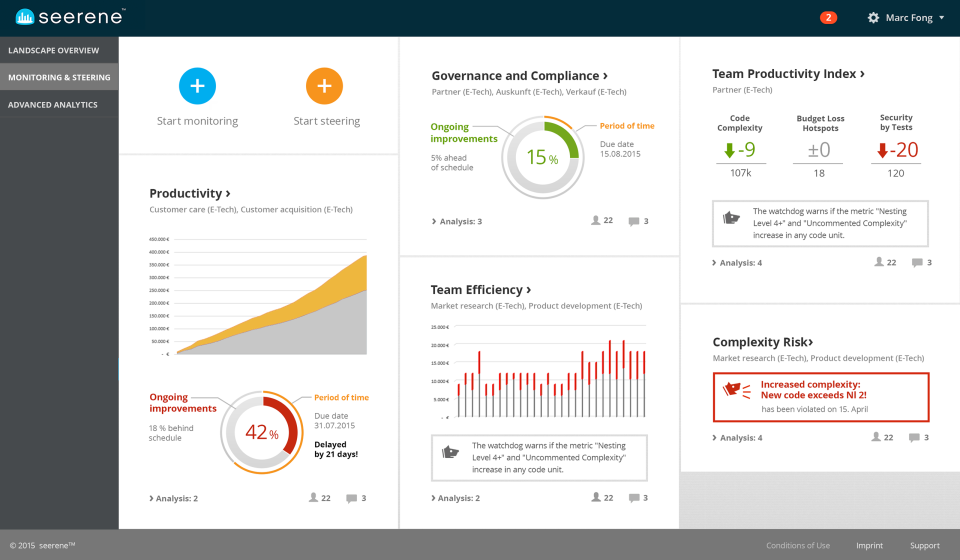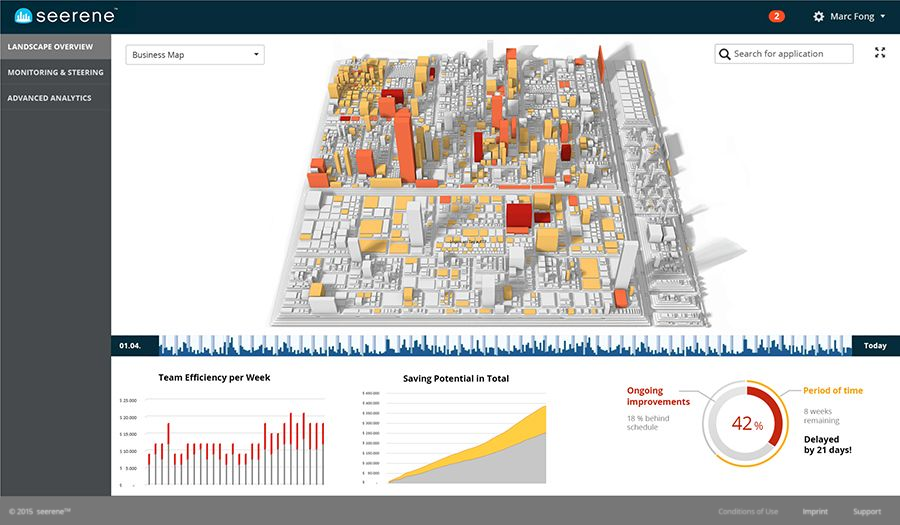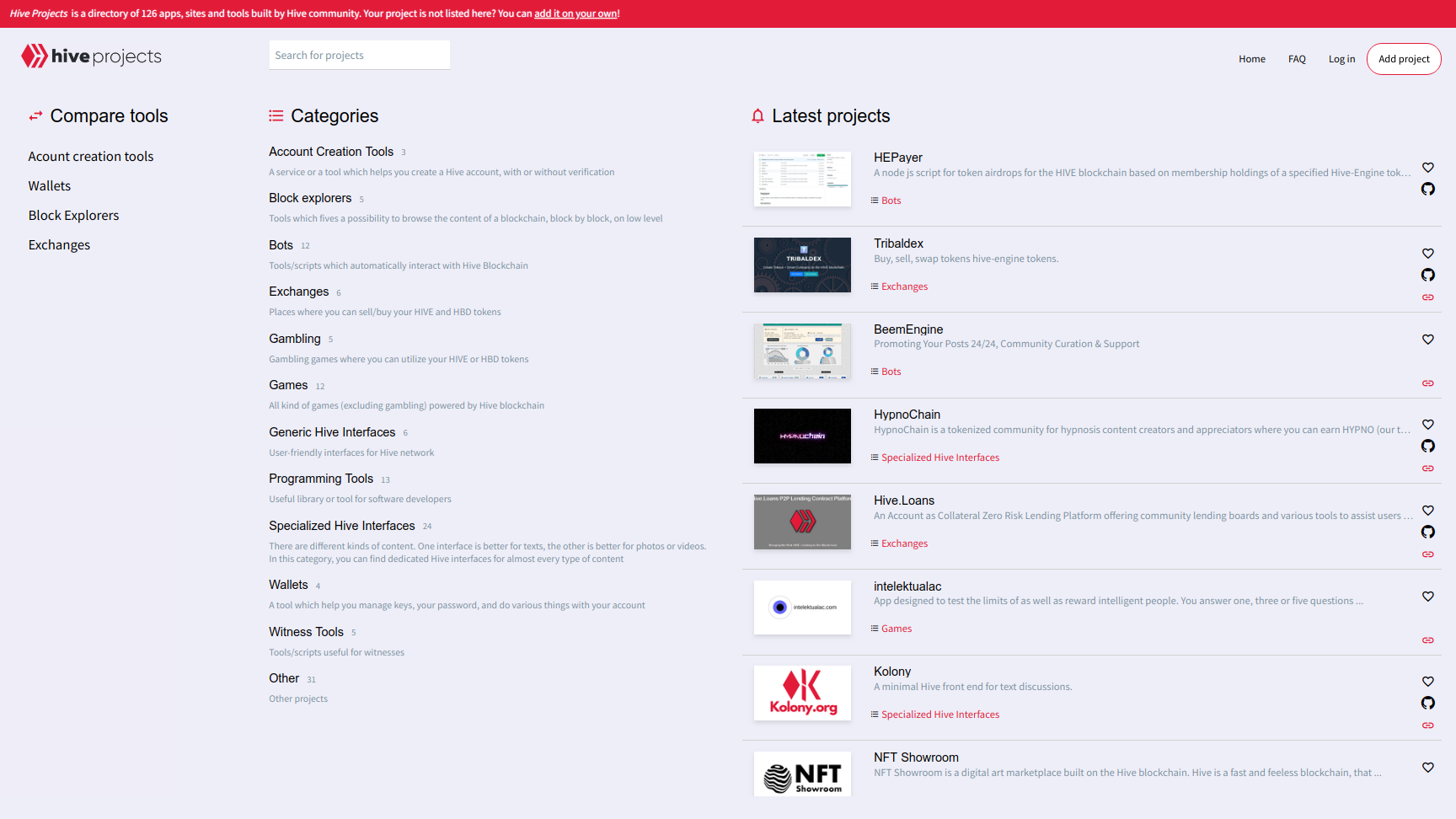Seerene

Project Background
Seerene describes their product as:Seerene’s Digital Boardroom is a software analytics and process mining technology that analyzes and visualizes the software development processes in your company. It reveals weaknesses and turns your organization into a well-oiled machine, delivering software efficiently, cost-effectively, quickly, and with the highest quality. Seerene provides decision-makers with the information needed to actively drive their organization towards 360° software excellence.
My Role in This Project
I've worked on Seerene during my years at Software House STXnext. It is a project of a German company of the same name. STXnext offered me the possibility to be a part of a small team of 3 developers, which goal was to show STXnext's ability to work on the development of this product, and thanks to that, convince the client to build with STXNext a bigger team or two, with more programmers, QAs and scrum master.
Challenges
New Frontend Framework
In 2015, I had a lot of experience with Django&Python, only some experience with jQuery and BackboneJS, but no prior experience with Angular JS. That was a challenge of its own for me.
Fortunately, our client and our team were long-term oriented, so we were embracing opportunities to learn new things if particular tasks were not critical. Everyone in a group was contributing the most in areas where he felt the strongest, but we created a culture of working on things outside of our area of expertise. That helped everyone in the team learn a lot of new things.
Bootstrapping New Team for a Client, New Code Base, No Know-How
Because we formed a new independent team, we started with a very narrow understanding of the codebase, with limited know-how about the whole project. We had contact with all in-house developers and a Product Owner from Seerene. As you can imagine, it was more challenging to learn about all the nitty-gritty details without having people with the knowledge inside the same room. To deal with that, we needed to spend a lot of time on talks via slack or video calls.
The critical part was to focus on asking the right questions, to understand things that were truly necessary to develop scoped tasks.
I believe the key to good performance was Planning and Estimation meetings, during which we together dissected all problems while trying to identify risks.
Lack of Infrastructure on Our End; Custom CI Build-System
To be able to work on a product efficiently, our team needed to also set up a few production-like instances of the project: our local production, staging, few test instances, which later were used by our QAs.
Earlier there were attempts to do those deploys with some basic bash scripts. Despite the simplicity, our team quickly realize that this solution was not flexible enough and wasn't scaling well.
At some point I started working on proper containerization with Docker of the whole thing, creating with Jenkins the building pipeline (CI), responsible for running all unit and E2E tests, but also capable of building new tests instances on-demand with just a few clicks. One of the most important features of that build system (which speeds up the work of our QAs significantly), was the ability to clone prepared databases between instances, with just a few clicks.
All instances build on-demand were also always automatically dynamically set up with their separate subdomain and with the support of HTTPS & SSL certificates.
I've built that build system on my own from scratch using Cookiecuttter library and its Jinja template language. That helped keep the whole thing very simple, yet powerful and robust.
Before I left STXNext and this project, I've successfully transferred all my knowledge about this build system to other developers, which I believe also proved it was easy to understand also from the code's perspective.
Optimizing the Speed of Database Queries
To be precise, it was not something on which I've worked personally, however, my team did. I've decided to mention this anyway, because of the fact how this task was handled. Two guys from our team, which were the most into databases... decided to work on this together. Pair programming, analyzing, refactoring took them over a month, however, the result was stunning. Without any major hiccups, they optimized the execution time of business-critical queries, from dozens of minutes to hundreds of milliseconds.
While working in this team, I've learned how powerful pair-programming can be as a tool to develop quickly important parts of code with high quality in mind. Additionally, this speeds up the learning process of participating developers tremendously. I've personally used that technique many times later within that project, on a smaller scale. Since then, I'm a huge fan of pair programming! (Which BTW, what my other project proved to me... can be successfully done also while working remotely!)
Biggest Lessons Learned
Often the biggest lessons you learn happens after some big mistakes. Fortunately, this time it was not like that.
The most outstanding thing for me was a realization, that with the right process in place and the right people, it is very possible, to work efficiently as a group of developers, without a manager or an official team leader. Our team was proof that it is possible to create a team, which can self-organize its work. In my opinion, it was possible mainly thanks to our Scrum Master (who off-loaded us in many ways from organizational tasks, which however was not our supervisor).
What's the point of that, you may ask? Personally, it was making a huge difference for me knowing that STXNext and its client believed in us and trusted us, that we are capable of organizing our work on our own. I believe thanks to that everyone in the team felt more empowered and cared about the outcome even more.
I remember Krzysztof as a very helpful person with a positive attitude who always shares constructive feedback with others. He was very active during ceremonies/meetings, sharing his knowledge across the whole team. During our work in STXNext, Krzysztof created a cool build system that was very, very helpful in daily work. I always heard from other developers, that Krzysztof writes good, clean, and well-designed code, and his solutions always meet given ACs. He was also supporting less experienced coders. I value Krzysztof's quality highly. in my opinion, he meets all requirements for a full-stack developer. What is most important, Krzysztof always respects the client and the project.
Summary
When I've started working on this project, there were just 3 developers from STXNext working on that. I believe the work of this initial team was crucial in a process of building a strong and long-lasting relationship of STXNext and its client, which before I left... resulted in the existence of 2 big teams, with 5 devs & 2 QAs, Scrum Master and Pruduct Owner in each.









